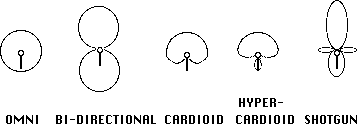When referring to “microphone patterns,” you are likely talking about the polar patterns or pickup patterns of microphones. The polar pattern of a microphone describes the directional sensitivity of the microphone to sound waves coming from different directions. There are several classic or “old” microphone patterns that have been widely used in the history of audio recording. Here are some common ones:
- Cardioid Pattern: A cardioid microphone is most sensitive to sound coming from the front and less sensitive to sounds coming from the sides and rear. This pattern is heart-shaped when plotted on a graph, giving it the name “cardioid.” Cardioid microphones are versatile and commonly used for recording vocals and instruments.
- Omnidirectional Pattern: An omnidirectional microphone captures sound equally from all directions. It has a spherical or circular polar pattern. Omnidirectional microphones are ideal for capturing ambient sounds or when a uniform response to sound from all directions is desired.
- Figure-8 (Bidirectional) Pattern: A figure-8 microphone is sensitive to sounds coming from the front and rear but rejects sounds coming from the sides. The polar pattern looks like the number 8, hence the name. Figure-8 microphones are often used for recording two sound sources on opposite sides of the microphone.
- Super/Cardioid and Hyper/Cardioid Patterns: These patterns are variations of the cardioid pattern. Super-cardioid and hyper-cardioid microphones have a more focused directionality, with a narrower sensitivity to the sides and a more pronounced pickup from the front.
- Shotgun (Lobar) Pattern: A shotgun microphone has a very directional pattern, highly focused on the sound coming from the front and rejecting sounds from the sides and rear. This pattern is advantageous for capturing distant or specific sounds while minimizing background noise.
- Bi-Directional Pattern: Similar to the figure-8 pattern, a bi-directional (or bidirectional) microphone is sensitive to sounds from the front and rear but rejects sounds from the sides. This pattern is useful for recording two sound sources facing each other.
Understanding microphone patterns is crucial when choosing a microphone for a specific recording scenario. Different patterns are suitable for different applications, and the choice depends on factors such as the type of sound source, the acoustics of the recording environment, and the desired result. While modern microphones continue to use these classic patterns, advancements in technology have also led to the development of microphones with variable or adjustable patterns to provide greater flexibility in capturing sound.

Omni
The simplest mic design will pick up all sound, regardless of its point of origin, and is thus known as an omnidirectional microphone. They are very easy to use and generally have good to outstanding frequency response.
Bi-directional
It is not very difficult to produce a pickup pattern that accepts sound striking the front or rear of the diaphragm, but does not respond to sound from the sides. This is the way any diaphragm will behave if sound can strike the front and back equally. The rejection of undesired sound is the best achievable with any design, but the fact that the mic accepts sound from both ends makes it difficult to use in many situations. Most often it is placed above an instrument. Frequency response is just as good as an omni, at least for sounds that are not too close to the microphone.
Cardioid
This pattern is popular for sound reinforcement or recording concerts where audience noise is a possible problem. The concept is great, a mic that picks up sounds it is pointed at. The reality is different. The first problem is that sounds from the back are not completely rejected, but merely reduced about 10-30 dB. This can surprise careless users. The second problem, and a severe one, is that the actual shape of the pickup pattern varies with frequency. For low frequencies, this is an omnidirectional microphone. A mic that is directional in the range of bass instruments will be fairly large and expensive. Furthermore, the frequency response for signals arriving from the back and sides will be uneven; this adds an undesired coloration to instruments at the edge of a large ensemble, or to the reverberation of the concert hall.
A third effect, which may be a problem or may be a desired feature, is that the microphone will emphasize the low frequency components of any source that is very close to the diaphragm. This is known as the “proximity effect”, and many singers and radio announcers rely on it to add “chest” to a basically light voice. Close, in this context, is related to the size of the microphone, so the nice large mics with even back and side frequency response exhibit the strongest presence effect. Most cardioid mics have a built in lowcut filter switch to compensate for proximity. Missetting that switch can cause hilarious results. Bidirectional mics also exhibit this phenomenon.
Tighter Patterns
It is posible to exaggerate the directionality of cardioid type microphones, if you don’t mind exaggerating some of the problems. The Hypercardioid pattern is very popular, as it gives a better overall rejection and flatter frequency response at the cost of a small back pickup lobe. This is often seen as a good compromise between the cardioid and bidirectional patterns. A “shotgun” mic carries these techniques to extremes by mounting the diaphragm in the middle of a pipe. The shotgun is extremely sensitive along the main axis, but posseses pronounced extra lobes which vary drastically with frequency. In fact, the frequency response of this mic is so bad it is usually electronically restricted to the voice range, where it is used to record dialogue for film and video.